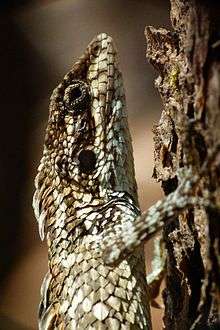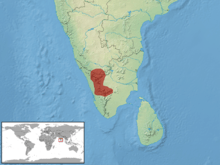Salea horsfieldii
| Salea horsfieldii | |
|---|---|
 | |
| Side view of the head | |
| Scientific classification | |
| Kingdom: | Animalia |
| Phylum: | Chordata |
| Subphylum: | Vertebrata |
| Class: | Reptilia |
| Order: | Squamata |
| Suborder: | Iguania |
| Family: | Agamidae |
| Subfamily: | Draconinae |
| Genus: | Salea |
| Species: | S. horsfieldii |
| Binomial name | |
| Salea horsfieldii Gray, 1845 | |
 | |
Salea horsfieldii, commonly known as Horsfield's spiny lizard or the Nilgiri salea, is a species of agamid, which is endemic to the Nilgiri Hills of India.[1] It is found mainly in the high altitude grassy hills. A related species, Salea anamallayana, is found in the grassy hills of the Anaimalai Hills.
Etymology
The specific name, horsfieldii, is in honor of American naturalist Thomas Horsfield.[2]
Description

This olive brown to green lizard with a white banded appearance has a snout that is about 1.5 times as long as the eye diameter which is about twice the diameter of the ear opening. The scales on the head are large and rough. Some scales around the brow above the eye are curved. A row of three or four large scales are found between the eye and the ear opening. The scales on the throat are lanceolate, keeled and sharp tipped. The male has crest on the back of the neck made up of a few lanceolate spines facing backwards. The dorsal crest continues after a break behind the nuchal crest. The scales on the upper surface are large, rhomboidal, strongly keeled, pointing straight backwards; these are nearly always of unequal size, larger ones being scattered on the sides; ventral scales very strongly imbricate, strongly keeled and ending in a spine, nearly as large as the dorsals. Limbs are somewhat long and when the hind limb is held along the body, the toes reach between the shoulder and ear opening. The tails is compressed and in the male has a small crest and is crestless in the female. The caudal scales are sub-equal and strongly keeled.[3]
The colour is pale olive above but varies from green to brown, with irregular dark-brown cross bands, often broken up by a band of the light-brown colour running along the sides of the back. The larger scales on the sides are frequently white and a blackish band edged below in white extends from the eye, through the tympanum, to the foreleg. The tail is banded with regular dark brown and creamy bands. The length from snout to vent is about 3.75 inches and the tail measures 9.75.[3]
References
- 1 2 Srinivasulu C, Srinivasulu B, Vijayakumar SP, Ganesan SR, Ramesh M, Ganesh SR, Manthey U (2013). "Salea horsfieldii". IUCN Red List of Threatened Species. Version 2014.2. International Union for Conservation of Nature. Retrieved 7 November 2014.
- ↑ Beolens B, Watkins M, Grayson M. 2011. The Eponym Dictionary of Reptiles. Baltimore: Johns Hopkins University Press. xiii + 296 pp. ISBN 978-1-4214-0135-5. (Salea horsfieldii, p. 126).
- 1 2 Boulenger GA. 1890. The Fauna of British India, Including Ceylon and Burma. Reptilia and Batrachia. London: Secretary of State for India in Council. (Taylor & Francis, printers). xviii + 541 pp. (Salea horsfieldii, pp. 131-132).
Further reading
- Boulenger GA. 1885. Catalogue of the Lizards in the British Museum (Natural History). Second Edition. Volume I. Geckonidæ, Eublepharidæ, Uroplatidæ, Pygopodidæ, Agamidæ. London: Trustees of the British Museum (Natural History). (Taylor and Francis, printers). xii + 436 pp. + Plates I-XXXII. (Salea horsfieldii, pp. 312–313).
- Das I. 2002. A Photographic Guide to Snakes and other Reptiles of India. Sanibel Island, Florida: Ralph Curtis Books. 144 pp. ISBN 0-88359-056-5. (Salea horsfieldii, p. 81).
- Gray JE. 1845. Catalogue of the Specimens of Lizards in the Collection of the British Museum. London: Trustees of the British Museum. (Edward Newman, printer). xxvii + 289 pp. (Salea horsfieldii, new species, p. 242).
- Smith MA. 1935. The Fauna of British India, Including Ceylon and Burma. Reptilia and Amphibia. Vol. II.—Sauria. London: Secretary of State for India in Council. (Taylor and Francis, printers). xiii + 440 pp. + Plate I + 2 maps. ("Salea horsfieldi [sic]", pp. 177–179, Figure 52).
External links
| Wikimedia Commons has media related to Salea horsfieldii. |
